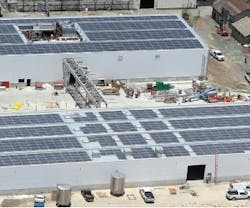What goes into making green wine? The Hall Estate Winery’s new two-building, 41,900-square-foot production and storage facility uses PV panels, a radiant floor heating and cooling system, and other sustainable measures to help the project be earth-friendly, save energy, and become the first winery in California to get LEED Gold certification.
Constantly Keeping Cool
Radiant floor heating and cooling has been around for decades and has become a popular energy-saving heating technique. However, radiant floor cooling hasn’t been as popular in the U.S. as it has been in Europe. Only recently has this energy-efficient cooling technique started to be examined and installed.
Winery production and storage facilities require precise and constant levels of temperature and humidity – the ideal storage condition is the well-known "55 at 85," which means 55 degrees at 85% humidity. This can take an elaborate – and costly – energy-intensive conventional HVAC system, especially when Napa Valley’s typical hot and dry summers are taken into consideration. To reduce energy use and environmental impact, the winery opted to install a radiant floor heating and cooling system to address the majority of the facility’s cooling needs, along with a conventional system to address humidity.
"Nearly 16 miles of special water pipe, buried 10 inches deep in a concrete slab floor, help to create cavelike room temperatures in Hall St. Helena winery’s Napa Valley storage and production facilities, even in summer-time heat," says Peter Simmonds, senior associate with IBE Consulting Engineers. "It is the first documented commercial use of ‘radiant flooring’ in a Napa Valley winery, and perhaps in the entire domestic wine industry."
Cross-linked polyethylene (PEX) pipes were embedded almost a foot deep into the 20-inch thick solid concrete, next to the rebar. These flexible pipes are just 5/8 of an inch in diameter, placed about 6 inches apart, and curve around when they reach the end of the floor and run back again – replacing the 90-degree, threaded "elbows" that are required to make a U-turn when using copper or steel pipes.
While this may be costly to implement in a retrofit, the cost difference between installing this and installing a conventional system was relatively small because the project was new construction, and the lowered operating costs further offset the small increase in construction costs.
The water that flows through the radiant flooring pipes is cooled to 42 degrees Fahrenheit by high-efficiency chillers before being pumped through the 83,880 linear feet of embedded pipe, which cools the mass, explains Simmonds. This addresses the majority of the temperature needs of the winery, but not the humidity. Supplementary air-conditioning, heating, and humidifier units help to maintain temperature and humidity stability – these systems primarily address the humidity, as most of the cooling is taken care of by the radiant floor.
Supplemented by the Sun
While the radiant flooring system reduces the amount of energy that the facility requires for heating and cooling, it isn’t the only sustainable measure that the winery is taking. The energy needs of the facility are further reduced by the 42,000 square feet of photovoltaic panels on top of the two structures. Approximately 35% of the winery’s electrical needs are provided by the solar roofs.
Most projects consider price and output when determining whether to install solar – appearance and location of the panels also had to be considered for this project, as the architect was Frank Gehry, FAIA.
"There were some additional challenges," says Simmonds. "The roofs, for example, were not designed to handle the additional weight of solar panels, given the configuration of the panels. That problem was solved by eliminating the solar panel support structure and connecting the panels directly to the standing roof seams."
The potential challenge of keeping the solar panels clean, which ensures that they will continue operating at maximum performance, was solved by installing a catwalk system so that a hose and brushes can be used to periodically clean the panels.
In addition to these systems, the winery used local building materials in the construction of the facility and various water conservation methods – such as drought-tolerant plants and recycled water for irrigation – which contribute to the facility’s LEED Gold certification and green wine.
Kylie Wroblaski is assocate editor of BUILDINGS.
